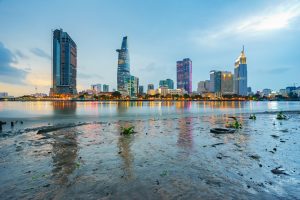Recently, the International Monetary Fund altered Vietnam’s economic growth forecast for 2022, revising it upward from 6 to 7 percent. This was the only significant upward revision among Asia’s economies, and higher than other major regional economies such as India, Japan, and China, the projections for which were all reduced by between 0.7 and 1.1 percent. This week, the World Bank similarly revised its projection for Vietnam’s economic growth from 5.3 percent to 7.2 percent, the highest figure for any nation in East and Southeast Asia.
Although surprising to many, this was foreseeable to those who have followed Vietnam closely for the last few decades. Quietly, Vietnam has transitioned from being one of the poorest global economies to one of the fastest growing, while the intensifying great power competition between China and the United States has only aided its recent growth.
After the U.S. military retreated from Vietnam in 1975, the country’s economy experienced severe developmental issues resulting from the inefficiencies of a centrally planned economy, residual war effects, and low productivity rates that made it import-dependent. Meanwhile, Vietnam’s invasion of Cambodia in 1979 to remove the Khmer Rouge government complicated these economic woes by redirecting resources to the war effort while also making Vietnam vulnerable to international pressure, including U.S. sanctions and the retaliatory Chinese invasion. These economic deficiencies and global tensions resulted in Vietnam’s economy being one of the poorest in Asia, with a GDP growth rate of 2.8 percent in 1985 and a 378 percent inflation rate in 1986.
However, in 1986 the Vietnamese Communist Party (VCP) set out to transform its economy from a centrally planned model to one that utilized market forces to allocate resources. The reforms, known as doi moi, encouraged private industry, recognized private land rights, and abolished collective farming. These changes, along with Vietnam’s military withdrawal from Cambodia in 1989, set the country on a course toward one of the quickest and most impressive periods of economic development in world history.
When the VCP first implemented the reforms, Vietnam was one of the poorest countries in the region, with a poverty rate above 70 percent. By 2020, this rate had declined to 5 percent, and over 10 million people have been lifted out of poverty in the 2010s alone. The country’s GDP per capita also increased nearly tenfold from under $300 in the 1980s to $2,800 in 2020.
As Vietnam’s economy has rapidly developed, and because its labor standards have remained low, it has become a more attractive place for investment. It has also become a key part of the global supply chain for textiles, footwear, and electronic manufacturing: textiles and footwear made up 18 percent of its exports in 2018, while electronics and electrical equipment made up 40 percent. Major companies like Adidas, Nike, and Samsung, among many others, now have a manufacturing presence there. Not surprisingly, Vietnam’s foreign direct investment (FDI) has grown over 200 times since 1986, from $40,000 in 1986 to around $15.8 billion in 2018. Meanwhile, its exports increased by 19 percent from 2020 to 2021.
More recently, Vietnam has been a beneficiary of the great power competition between the United States and China as it relates to FDI. As the tension between the United States and China grows, the Chinese Communist Party has taken a less business-friendly posture, and China’s COVID-19 policy has become draconian and seemingly permanent, businesses have begun looking to diversify their supply chains to mitigate against any disruptions. In 2021 alone, at least 11,000 foreign firms canceled their company registration in China, a stark contrast with the net increase of 8,000 foreign firms registered in 2020. Among others, companies like Apple, Samsung, and Hasbro, which have had significant and longstanding manufacturing operations in China, have decided to reduce their operations in the country.
Vietnam has benefited as major companies have moved their manufacturing there to take advantage of the low costs, developed infrastructure, supportive business environment, and success in mitigating the economic effects of COVID-19. For instance, Foxconn, the prominent electronic manufacturer that contracts with all major technology companies, including the behemoth Apple, announced it would invest $300 million in a new factory in northern Vietnam. Google announced recently that it plans to shift as much as half of the production of its Pixel Phones to Vietnam, while Microsoft has utilized Vietnam for some of its Xbox production. A few years ago, these corporations would have exclusively produced these items in China. Overall, Vietnam’s FDI increased 8.9 percent between January and June of this year compared to the same period in 2021.
Still, Vietnam faces severe hurdles to future growth. The most limiting factor is the country’s population size, which will never amount to more than a fraction of China’s. Similarly, Vietnam’s workforce is relatively low-skilled, its energy supply is having a hard time keeping up with demand, and although the country has made significant advances in infrastructure development, it still ranks 47th out of 160 countries in this regard.
Nevertheless, Vietnam has made incredible economic gains over the last 40 years, which has made it an attractive FDI destination. Moreover, as the consequences of the growing Chinese and American divide negatively affect the ease of purchasing goods, and given Vietnam’s role as an attractive investment destination to China, we should expect the country’s economic forecast to trend increasingly positively in the years to come.

































